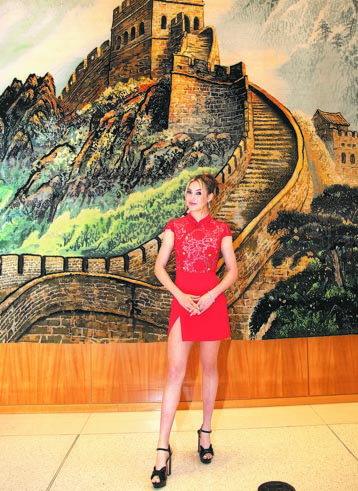Resurgent qipao bridges time, heritage in New York


Timeless bond
Forging a timeless bond between its owners, the unique qipao, probably 60 or 70 years old, transitioned from being sealed in a box to starting a new life.
A qipao also offers an opportunity for young Chinese to trace their cultural identity, and many overseas Chinese students in their 20s are choosing to wear qipao under their caps and gowns when walking on the stage to celebrate their accomplishments.
Some used the #graduationwithqipao hashtag on both Chinese and US social media sites to share their experiences.
Yang Huan, a graduate of the Parsons School of Design in New York, wore a qipao at this year's graduation ceremony.
"I would like to wear the clothes that represent me on this special occasion," Yang said. "It is indeed very meaningful to me."
Yang chose two qipao to wear to her school and college graduation ceremonies. She said she felt proud wearing traditional clothes that represented her heritage and Chinese identity.
She said her classmates told her she looked "amazing", and she was also interested in showing them traditional Chinese clothes, in the hope of piquing their interest in Chinese culture.
Yang's ancestral home is in Anhui province, and she said wearing a qipao was also her way of representing her family, and especially her mother. But she said her mother would have preferred her to wear a straight qipao, which is loose at the chest and waist.
Yang chose a Hong Kong-style qipao that has a tighter fit and contours a woman's curves.
"Perhaps in the past women in prestigious families would not show their figure excessively, and they were very conservative," Yang said.
After studying abroad in the US for almost 10 years since middle school, Yang said she has her instincts as a Chinese woman but also wants to embrace Western culture.
Not only did she wear the qipao, but Yang also completed her bachelor's thesis, an illustration project, on Chinese traditions.
Her thesis project, titled Let the Brush Stroke Speak for the Memories, was a series of four illustrations that captured her childhood memories and her grandfather. The project was also filled with Chinese cultural elements, such as fish lanterns, the lion dance, blessing fu characters, and traditional snacks.
"No matter about the qipao or my project, I think my painting style is very Chinese. I've been using my expertise to disseminate Chinese culture ... That's my instinct. My instinct, guided by my heritage and identity, determines my visual language. It's what makes me who I am."
The qipao continues to evolve, and the exchange and collision with Western aesthetics and culture updated it during the 1970s.
In the late Qing Dynasty, imperialist powers invaded China and forcibly opened the gates of China. The Chinese suffered from this kind of interference, but they also took Western culture into China, which left an effect on Chinese clothing, said Zhao Lianshang, a researcher at the Chinese Academy of Social Sciences in Beijing.
"We know that we must exchange with the international community, whether active or passive. We also sent Chinese international students out for interactions, bringing Chinese clothing out," he said.


















